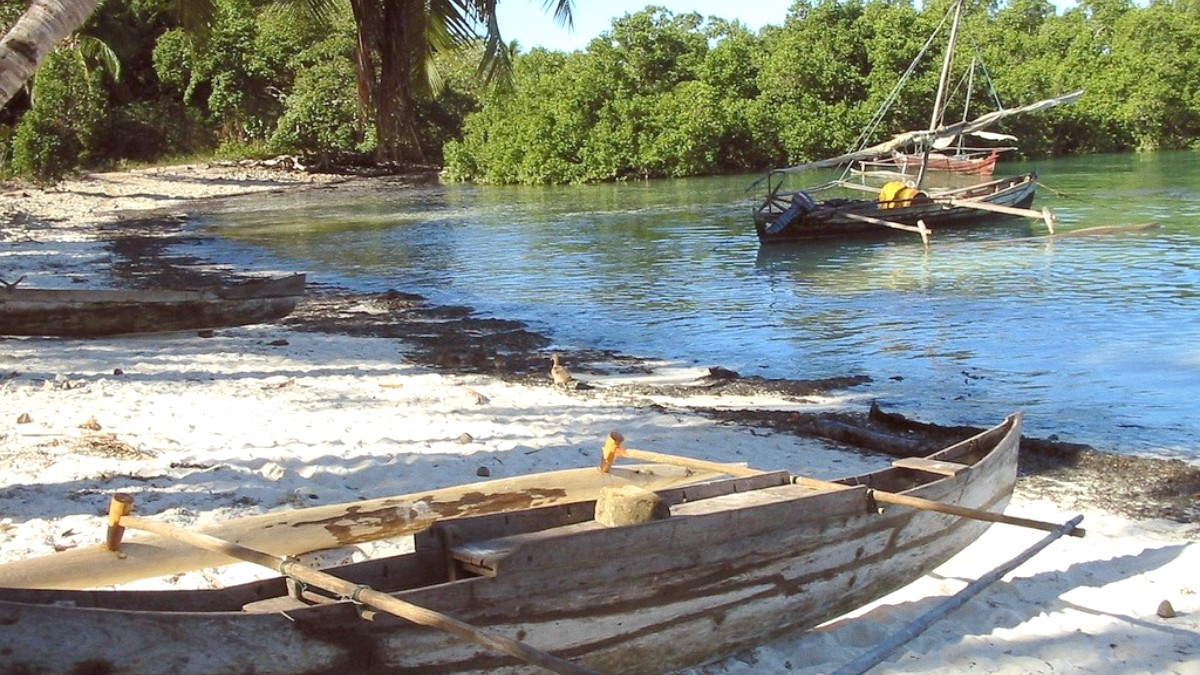
Explore the tangible remnants of World War II's Battle of Tarawa, one of the Pacific theater's most pivotal battles. Find Japanese fortifications, concrete bunkers, coastal defense guns, and memorial sites (Red Beach, Japanese Memorial, US Memorial).
These sites offer a powerful, somber connection to a defining moment in recent history.
Seek local contacts or hotel assistance for guided tours for WWII sites. Book tours on GetYourGuide.
World War II sites in Betio (gun emplacements, bunkers, tanks) are the main focus for military history tourism.
Betio Port serves as the main industrial area.
Historical sites related to phosphate mining exist on Banaba (Ocean Island), but access is very difficult.
Banaba is hard to visit due to limited transport and infrastructure.
Kiribati sees few tourists, even popular WWII sites have minimal visitors.
The true natural beauty of Kiribati resides in its expansive lagoons, intricate reefs, and undeveloped islets.
Snorkeling and diving reveal diverse fish, sea turtles, rays. Reef health varies.
Coconut crabs (Birgus latro) on less inhabited islands.
Kiritimati hosts enormous seabird populations. Phoenix Islands Protected Area (PIPA) is a UNESCO site, very difficult to visit. Find birdwatching tours.
Lagoon and ocean views are accessible from coasts. Causeways in South Tarawa offer expansive lagoon views, especially at sunset.
Spectacular sunsets over the ocean are a daily occurrence. Undisturbed islets offer pristine environments.
Atolls are the main geological feature: low-lying coral rings surrounding a central lagoon. Highest points are a few meters above sea level. Coastal erosion is visible.
Beach quality varies. Some lagoon-side beaches in South Tarawa have pollution. More pristine beaches are on outer islets or less populated atolls.
Large bodies of water within the atoll ring. They offer calmer waters for swimming and some water activities compared to the open ocean.
Kiribati has no significant freshwater lakes or rivers. Small brackish ponds may exist inland on some islands.
Beyond the commonly known sites, Kiribati offers opportunities for unique, off-the-beaten-path discoveries.
Kiribati generally sees few tourists, so popular World War II sites in Betio see minimal visitors at any given time. Explore the coastline in Betio at low tide to glimpse some submerged remains of the battle, an unique and poignant sight.
When visiting cultural and historical sites, respect local customs and the significance of the locations.
Be respectful when photographing war memorials or ruins. Do not disturb any remains.
Visit the World War II sites in Betio early morning or late afternoon to avoid intense midday heat and harsh sun.
Capture the unique character and beauty of Kiribati through these moments.
Genuine local experiences are found in unexpected places.
General tips for a respectful and rewarding visit.
The tropical sun is intense. Use high-SPF sunscreen, wear a wide-brimmed hat, and seek shade during peak hours.
A warm smile and a polite demeanor go a long way. Engage with locals, learn a few I-Kiribati phrases, and respect their way of life.
Dispose of all trash properly. Avoid littering, especially plastics, which harm the fragile atoll environment.
For detailed accounts of the Battle of Tarawa, consult historical archives and documentaries.
Explore historical toursLearn about Kiribati's efforts in marine protection, notably the Phoenix Islands Protected Area (PIPA).
Discover eco-toursDeepen your appreciation by researching I-Kiribati customs, folklore, and social structures.
Educate yourself on the unique geology and delicate ecosystems of atolls.
Kiribati is at the forefront of climate change impacts; research their resilience efforts.
Guided options for WWII history on Betio are possible through some hotels or local contacts. No formal tour companies with fixed schedules.
Independent travel using public transport (bus/boat) is possible, but patience and flexibility are important.
Kiribati offers an authentic experience far removed from mass tourism. Your presence contributes directly to local livelihoods.
Embrace the unexpected and the simplicity of island life.
Capture the unique beauty and character of Kiribati.
Spectacular sunrises and sunsets over the vast lagoon or open ocean.
World War II sites in Betio, with their evocative ruins and memorials.
Candid shots of daily life in villages and markets (with permission).
Wander through the remnants of the fierce WWII battle. See bunkers, guns, and memorials.
Book your historical tourExperience the heart of community life in a traditional meeting house. Observe local decision-making or cultural events.
Immerse yourself in the bustling main market. Observe local commerce and daily routines.
Arrange a boat trip on the Tarawa lagoon for stunning sunset views and peaceful waters.
Take a boat to an uninhabited islet for pristine beaches and snorkeling away from populated areas.
Beyond landmarks, discover Kiribati's history through unique architecture and community structures.
Traditional spiritual sites are less visible to outsiders and integrated into local beliefs.